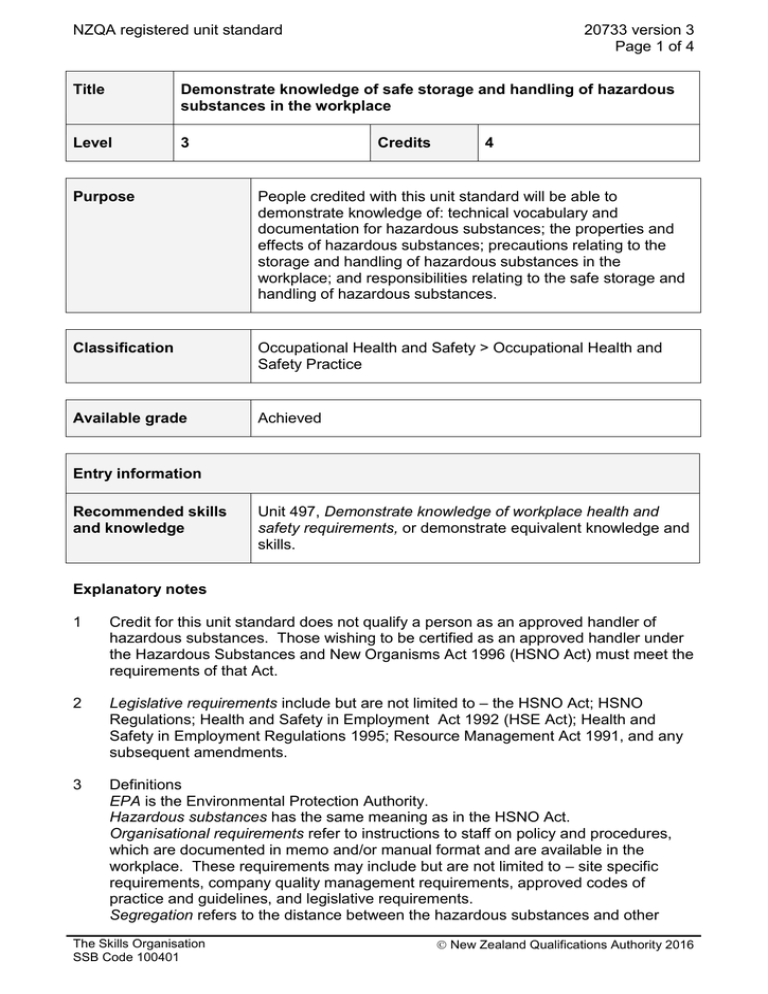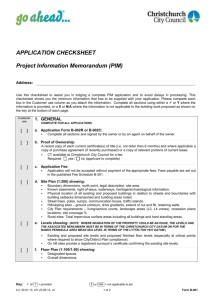NZQA registered unit standard 20733 version 3 Page 1 of 4
advertisement

NZQA registered unit standard 20733 version 3 Page 1 of 4 Title Demonstrate knowledge of safe storage and handling of hazardous substances in the workplace Level 3 Credits 4 Purpose People credited with this unit standard will be able to demonstrate knowledge of: technical vocabulary and documentation for hazardous substances; the properties and effects of hazardous substances; precautions relating to the storage and handling of hazardous substances in the workplace; and responsibilities relating to the safe storage and handling of hazardous substances. Classification Occupational Health and Safety > Occupational Health and Safety Practice Available grade Achieved Entry information Recommended skills and knowledge Unit 497, Demonstrate knowledge of workplace health and safety requirements, or demonstrate equivalent knowledge and skills. Explanatory notes 1 Credit for this unit standard does not qualify a person as an approved handler of hazardous substances. Those wishing to be certified as an approved handler under the Hazardous Substances and New Organisms Act 1996 (HSNO Act) must meet the requirements of that Act. 2 Legislative requirements include but are not limited to – the HSNO Act; HSNO Regulations; Health and Safety in Employment Act 1992 (HSE Act); Health and Safety in Employment Regulations 1995; Resource Management Act 1991, and any subsequent amendments. 3 Definitions EPA is the Environmental Protection Authority. Hazardous substances has the same meaning as in the HSNO Act. Organisational requirements refer to instructions to staff on policy and procedures, which are documented in memo and/or manual format and are available in the workplace. These requirements may include but are not limited to – site specific requirements, company quality management requirements, approved codes of practice and guidelines, and legislative requirements. Segregation refers to the distance between the hazardous substances and other The Skills Organisation SSB Code 100401 New Zealand Qualifications Authority 2016 NZQA registered unit standard 20733 version 3 Page 2 of 4 goods or other hazardous substances. Separation refers to the isolation distances, boundaries, protected works, or areas considered public places by law. Workplace has the same meaning as place of work in the HSNO Act and the HSE Act. 4 Reference material includes Codes of Practice and Guidelines approved by EPA and recommended as a means of compliance with the HSNO Act. Outcomes and evidence requirements Outcome 1 Demonstrate knowledge of technical vocabulary and documentation for hazardous substances. Evidence requirements 1.1 Terms used in relation to hazardous substances are identified and explained. Range 1.2 Marks used for identifying hazardous substances are identified and described. Range 1.3 includes but is not limited to – hazard classification, exposure limits, risk management organisations. includes but is not limited to – common name, class, United Nations number, HAZCHEM code warning statement. Documentation used for the identification of hazardous substances is identified and described. Range includes but is not limited to – dangerous goods declarations, emergency response procedures, Material Safety Data Sheets. Outcome 2 Demonstrate knowledge of the properties and effects of hazardous substances. Range an example of a hazardous substance is given for each range item. Evidence requirements 2.1 Common states of hazardous substances are identified. Range 2.2 Common properties of hazardous substances are identified. Range 2.3 gas, liquid, solid. explosive, flammable, corrosive, oxidising, toxic, ecotoxic. Means by which hazardous substances can harm people are described. The Skills Organisation SSB Code 100401 New Zealand Qualifications Authority 2016 NZQA registered unit standard Range 2.4 inhalation, ingestion, skin absorption, eye contact. Harmful effects of hazardous substances on people are described. Range 2.5 20733 version 3 Page 3 of 4 may include but is not limited to – poisoning, respiratory problems, burns, allergic reactions, rashes, cancer. Harmful effects of hazardous substances on the environment are described. Range may include but is not limited to – contamination of the air, land, and waterways. Outcome 3 Demonstrate knowledge of precautions relating to the storage and handling of hazardous substances in the workplace. Evidence requirements 3.1 Description includes precautions for hazardous substances in terms of personal safety. Range 3.2 Description includes precautions against hazardous substances in terms of organisational compliance. Range 3.3 includes but is not limited to – knowledge of substances used in the workplace, personal protective equipment, following safe operating procedures. includes but is not limited to – rules on compatibility, segregation, separation, storage, stacking height, handling, protecting staff and public from possible harm. Description includes precautions against hazardous substances in terms of environmental protection measures. Range includes but is not limited to – protection against exposure, spill response, emergency response plans, disposal. Outcome 4 Demonstrate knowledge of responsibilities relating to the safe storage and handling of hazardous substances. Evidence requirements 4.1 Description includes the responsibilities of the individual in terms of organisational procedures and legislative requirements. 4.2 Description includes the responsibilities of the organisation in terms of organisational procedures and legislative requirements. The Skills Organisation SSB Code 100401 New Zealand Qualifications Authority 2016 NZQA registered unit standard Planned review date 20733 version 3 Page 4 of 4 31 December 2015 Status information and last date for assessment for superseded versions Process Version Date Last Date for Assessment Registration 1 18 February 2005 N/A Review 2 25 May 2007 N/A Rollover and Revision 3 22 May 2014 N/A Consent and Moderation Requirements (CMR) reference 0003 This CMR can be accessed at http://www.nzqa.govt.nz/framework/search/index.do. Please note Providers must be granted consent to assess against standards (accredited) by NZQA, before they can report credits from assessment against unit standards, or deliver courses of study leading to that assessment. Industry Training Organisations must be granted consent to assess against standards by NZQA before they can register credits from assessment against unit standards. Providers and Industry Training Organisations, which have been granted consent and which are assessing against unit standards must engage with the moderation system that applies to those standards. Requirements for consent to assess and an outline of the moderation system that applies to this standard are outlined in the Consent and Moderation Requirements (CMR). The CMR also includes useful information about special requirements for organisations wishing to develop education and training programmes, such as minimum qualifications for tutors and assessors, and special resource requirements. Comments on this unit standard Please contact The Skills Organisation reviewcomments@skills.org.nz if you wish to suggest changes to the content of this unit standard. The Skills Organisation SSB Code 100401 New Zealand Qualifications Authority 2016




